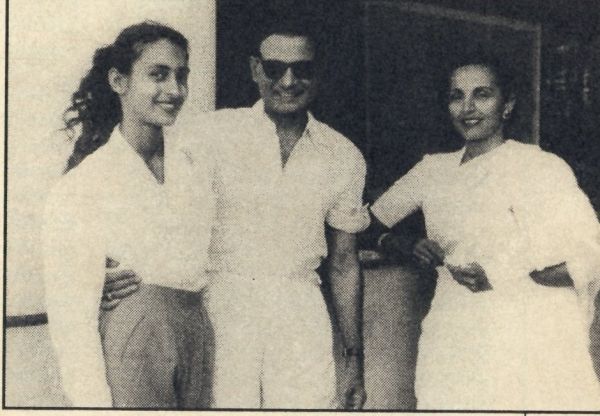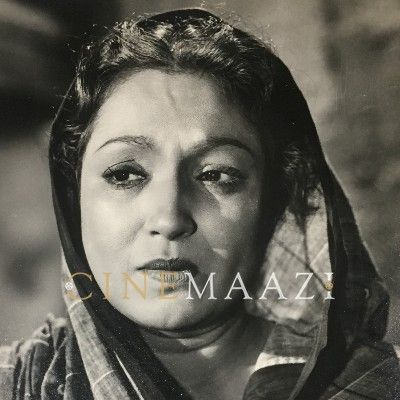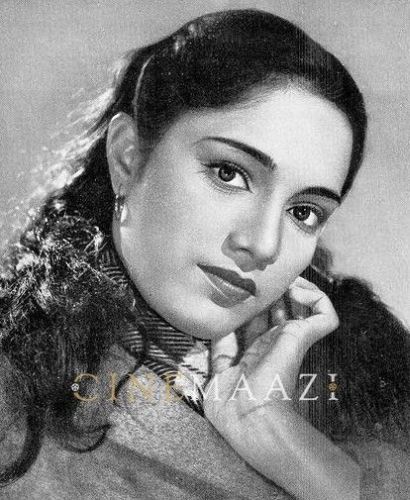Nutan : A Flashback - The Daughter
Subscribe to read full article
This section is for paid subscribers only. Our subscription is only $37/- for one full year.
You get unlimited access to all paid section and features on the website with this subscription.
Not ready for a full subscription?
You can access this article for $2, and have it saved to your account for one year.
Nutan wouldn't have been, had she not survived the accident I met with when I was three months pregnant with her. We were shooting for this film Do Diwane (1936), also made in Gujarati as Be Kharab Jan (Two Bad Men). There was a scene in which I was to be swinging in a hammock when it breaks. It so happened that while shooting, the strings really snapped and I fell heavily to the ground. The doctor was sceptical when he examined me and said that I might have a miscarriage. But, miraculously I didn't. My condition improved as days went by. Nutan had to be, so she survived, perhaps because I was destined to have so much sorrow. She had so much to give, both good and bad.
She was born on June 4, 1936, into a highly educated and cultured family on both sides. My father Dr. P.H.Shilotri was a banker in Bombay, my father-in-law N.M.Samarth was a member of the Indian Council in London and my husband, Kumarsen Samarth was the deputy publicity officer with Films Division. My husband and I happened to be inter-related. He and my mother were cousins. Hence he was my mama. I got engaged when I was 17, married at 18 and became a mother at 19. Nutan was my eldest child.
From a very young age, I engaged a dance and music teacher for Nutan. Not because I wanted her to become an actress, but apna shauk pura karne ke liye. She learnt Kathak and she loved it. When she was just two-and-a-half years old, she gave her first public performance at the Taj Mahal Hotel. My brother-in-law, R.N.Samarth had arranged it because some of his English associates were visiting India. Her second performance was, before a larger audience, at the New Empire theatre, where only a few days ago I had brought her to see Alladin And His Magic Lamp. While on stage, I noticed that slowly Nutan was moving towards the front of the stage and once there, she refused to go back to the centre. So, after the performance, I asked her, "baba (we all called her that), why were you dancing on the edge?" With huge, frightened eyes she answered, "mummy, that rakshas (the genie of Alladin film, she had seen a day earlier) was behind me and I was afraid he'd pick me up and take me away." Obviously, the fear from the film still lurked in her mind. Thereafter she gave several performances. She used to even sing at the CCI and later, after she became a star, she started to give musical programmes, titled `Nutan-Nite'
For seven-and-a-half years, Nutan was our only child. So we lavished a lot of attention on her. Her birthday every year, was a big celebration which all my celebrity friends like K.N.Singh, Motilal, David and others made a point to attend. The party would be hosted either in Bombay or Lonavala or Mussorie. This continued till she got married.

My husband was extremely fond of Nutan. He used to call her tangewala. There is a story how this name came about. It started with him calling her Changla baba (good child), it then became Changa baba— you know how we try to talk to children, in their own language, mispronouncing words as they do -then tanga baba and finally tangewala. There are so many incidents, but I remember this one which shows Nutan's immense will power and self respect. She must have been around four at that time And she had this habit of sucking a pacifier all the time. One day, her father, said to me within her hearing, "Jim (that's what he called me because my real name is Sarojini), our baba is very good, but thodasa naughty aahe chusni (pacifier) ghetai." That girl when she heard this, pulled out the pacifier, flung it away and never looked at it again. Now you know that if she could do that at four, she could, as she did, throw her mother out of her life at 25!!
When Nutan was nine-and-a-half and Tanuja two, I bought a farmhouse at a Lonavala. The two girls used to stay there with my mother. She took care of all my children (and later even some of my grandchildren) because I was very busy with my career. The girls went to a Lonavla school for a month, but the heavy rains there were troublesome and then one day, after they found a snake in the house, they returned to Bombay. I then put her in a boarding school in Bangalore. But she barely stayed there a week. I was in America, when Nutan wrote to me saying, "I hate it here. I can't eat beef and I can't bring myself to bathe with other girls." She was quite an inhibited girl. So, I wrote to my husband to bring her back to Bombay. She studied upto senior Cambridge in Hill Grange School here. It was while she was still in school, that I started making Hamari Beti (1950). One day, when Nutan accompanied me to a mahurat (she often accompanied me to shootings, races) she was looking very pretty and older than her 13 years. She was very tall, even taller than I. So, it wasn't surprising when K. Asif offered her a role in his film. That's when, for the first time, it occurred to me that why don't I make a film for my daughter.
At that time filmmaking was not such a big deal. I had about three-four lakh of rupees, which I invested in the film. I lost them of course, but Nutan was noticed. She was just fourteen then.
Hamari Beti was a home production in every sense. Motilal and I were the joint directors. Even the dialogues were written by Motilal and Kumar Jaywant, a relative of ours was the cameraman of the film. The furniture, food, car, everything except the raw stock and the studio hands came from home. The atmosphere was relaxed and we made the film according to our pace and convenience and yet, completed the project in six months.
Nutan was not keen initially, but once she took up acting, she devoted her life to it. During the making of Hamari Beti, she and Motilal used to rehearse the next day's scene on the previous day. They would do the whole scene with the movements, pauses, dialogues and the camera placement. She took guidance from him for this one film. After that, she took off on her own. She improved and evolved, she studied her faults and rectified them. She had this habit of twitching her lip. She noticed it while seeing the rushes and consciously worked to erase it. She was not a natural actress like Tanu. But she worked at her roles, her performances.
After Hamari Beti, reputed banners like Pancholi and Ranjeet offered her films. She acted in Nagina (1951) and Hum Log (1951) which were instant hits and a star was born! Because she was a mere girl, everyone treated her like a child on the sets, and perhaps also because she was on her own most of the time. No one accompanied her to the shootings. Besides, from the beginning, she was a very sober girl, undemanding, obedient. She never had to be reprimanded about anything. And she was least fussy about her clothes. She wore what she was given for the film.
1953-54, however, was her lean phase. All her films were flopping. That's when I decided to send her to finishing school in Switzerland. She was a lanky girl and everyone said she was too thin. I thought she could do with a bit of grooming. Before that, in 1952, we had gone to Mussorie and there, just for a lark, she entered a beauty contest. And to everyone's surprise, even her own, she was chosen Miss Mussorie.
While she was still in Switzerland, I received an offer for her from S Mukherjee. I thought it was a good chance because Filmalaya was a big name then. So I called her back from Switzerland. She now looked plump and nice. This time round, her career picked up and she did some very good roles which became the ideal and envy of her contemporaries and those actresses who came after her. She moulded herself and made sure that she fitted into the roles that she had accepted.
She would get very depressed if she hadn't given a good take. If she came home and rushed upto her room, climbing four steps at a time, it meant she was upset. She would sulk sometimes, but only because the director didn't allow her an extra take when she asked for it. She was never satisfied with her work. That is basically why she evolved to such a fine degree. I could tell, just looking at her, when she was hungry or unwell. So undemanding was she, that at times even if she was ill, she wouldn't wake me up in the night. But I could read her like a book. All this changed once she got married. We grew distant and then came the incident which severed our relationship for twenty long years.

Nutan and Tanuja were never really close. Maybe because both were poles apart, temperamentally. One was an introvert and the other an extrovert. Nutan never really approved of anything that Tanu did— "Vedich aahe" (she's crazy) she used to say to Tanu's naughty ways. But she was very close to my other daughter Chatura, who is ten years younger to Nutan. Nutan almost mothered her When Chatura was a baby, I had gone to America for a long period, leaving her in Nutan's care. During this time, she even fell ill and Nutan almost nursed her. Out of the family, Chatura is the most affected after Nutan's death. My youngest child, Jaideep and Nutan didn't have much to do with each other. He was born when she was twelve and by the time he was four or five, she was a busy star. Soon, he went to the boarding school and when he completed his schooling and returned, Nutan was married and our relations were strained. Only when he was very young, and would lie down in front of my car to stop me from going for shooting, did Nutan pick him up and distract him until my car had vanished from sight.
In 1983, Nutan and I made up. We became close like old times and never once mentioned the feud and the twenty-year silence that followed. We spent a lot of time together and went for satsangs. In her later years, she had become a satsangi. She was always a spiritual person, but not ritualistic. It's a family trait. We believe in God, in truth. My mother would say, go to my puja ghar with chappals on, but not with a dirty conscience. Because God is everywhere, even when you are walking on the road, in the muck, he is present. So, Nutan believed in those ideals too. We would go to Hubli together, because our guru lives there.
At the grassroot, she was a simple person. She did her own shopping, cleaned the house herself and never treated the servants as low. But somewhere along the way, she lost her will to live. This last year, after her operation, she knew it was the beginning of her end. She knew this and encouraged her sickness. If she had taken more care, she would have lived a few years more, but she had no will to survive. She would say, "I want to wake up, I am sleeping now."
What overwhelms me now, because I realised this only after her death, is the fact that gently but surely she prepared me to accept her death. She gave me a ring, which I am now wearing, with a specific stone saying, "wear it mummy, you'll need it. I have asked a jyotshi and he has adviced you to." She made it a point to drag me to these satsangs whose sole philosophic message was the futility of ties and their temporal nature. Then, she bought me a cassette of Anuradha Paudwal and asked me to listen to her favourite bhajan in it. It said "vyarth chintit kyon ho rahe ho/ laye the kya joro rahe ho." She was preparing me to bear this shock and the way in which she went about it...her calmness and caring makes me cry now. When she died, I didn't shed a tear I know and perhaps, she knew too that if this had happened at any other point of time, I wouldn't have been able to bear it. I would have merely swallowed fifty sleeping pills and commited suicide. Not because she was the centre of my existence, but because I wouldn't have been able to endure the sorrow, but I survived. This is life.
All through her illness, she was very brave. She never groaned or complained. Only on the last day, I heard her moan,"aai ga..aai ga.." And then, out of the blue came that one final scream "aa...i..ga.." It was so harsh, so painful, as if she had burst a sore. I heard it outside her room where I was sitting. I rushed inside, but it was too late. She was no more.
This article was originally published in the Junior G supplementary of March 1992 issue called Nutan : A flashback. The images used are taken from the original article.
Tags
About the Author







.jpg)


